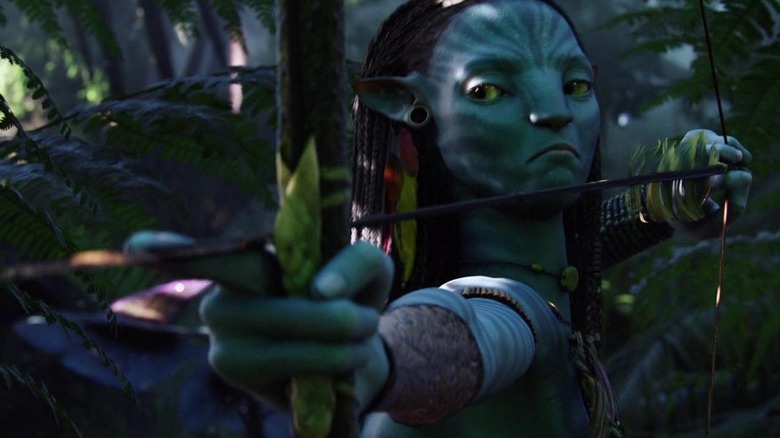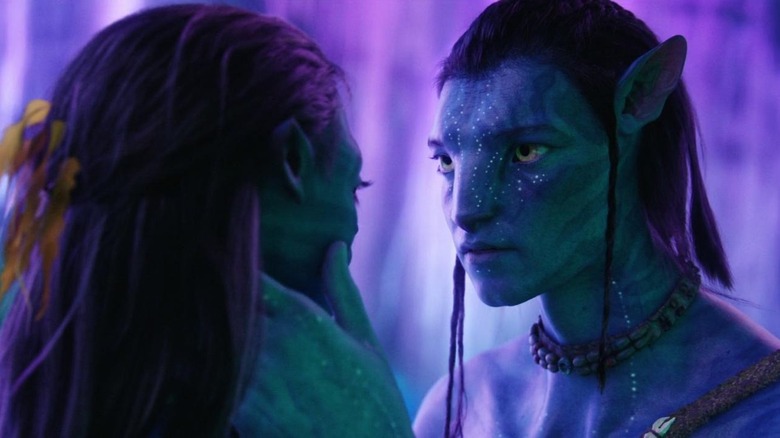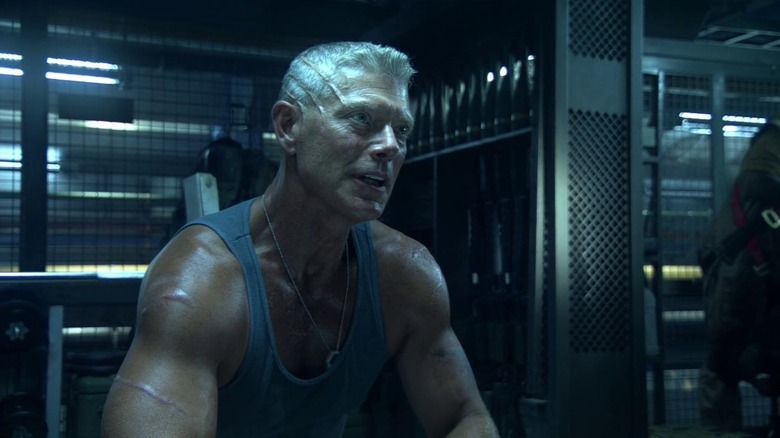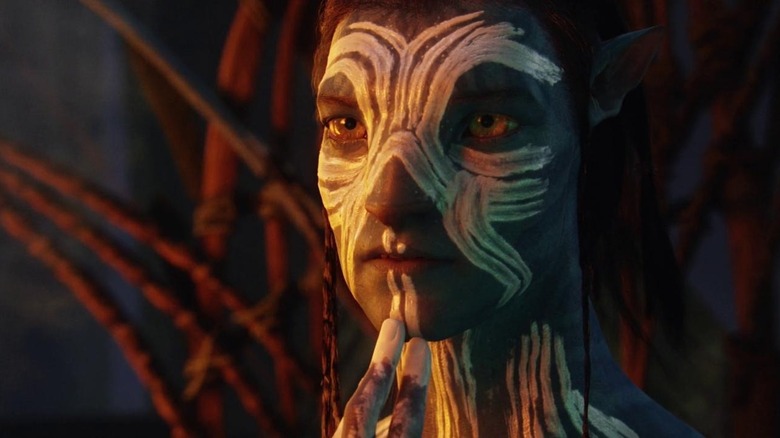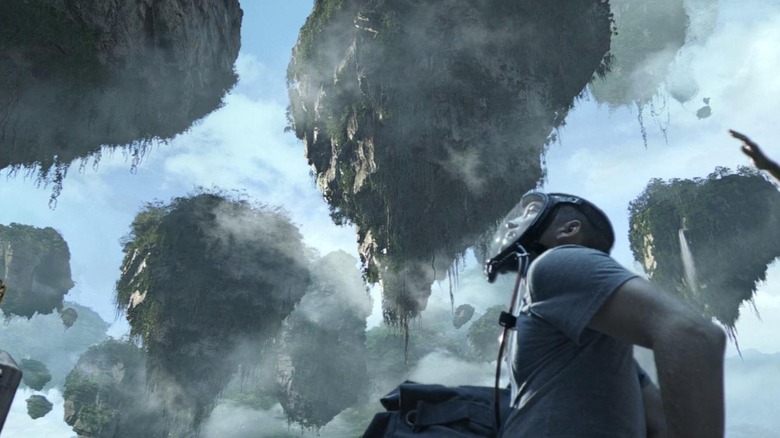James Cameron's Avatar Had A 10-Year Journey To Reach The Big Screen
The recent history of blockbuster cinema in the United States has played out as a series of bets against the director James Cameron. Before 1997, rumors spread that his new film "Titanic" had gone over budget and that the cast's food had been drugged with PCP. But after its release, it became the highest grossing film ever for a time and won 11 Oscars. Before 2009, "Avatar" was an ambitious film proposal about blue cat aliens in space that Fox didn't want to make. But then it became the first film to surpass the box office success of "Titanic," and a benchmark for modern visual effects. The only film to knock it from that pedestal has been "Avengers: Endgame," with which "Avatar" has since raced neck and neck in global box office totals.
At the time, it must have seemed ludicrous that a film like "Avatar" could ever be made. But Cameron and his team approached the project from a practical perspective. They chose to pursue "Titanic" initially rather than "Avatar," waiting for the special effects industry to evolve to the point where the alien world they envisioned could be realized. Then came a revolution in motion capture technology in the early 2000s, with Gollum from "The Lord of the Rings" films leading the way. Seeing that creating fantastical characters with believably human expressions had finally become feasible, Cameron's team pounced. They would do "The Lord of the Rings" one better: rather than simply augment the real world with computers, they would create one from scratch (including details not found in visual effects) and populate it with motion-capture aliens.
The invention of actor-based technology
According to a 10 anniversary retrospective in Variety, further challenges stood in the way of the production of "Avatar." One was constructing the world of Pandora: its wildlife, its languages, its people. Professor Paul Frommer produced the Na'vi language by combining sounds from multiple languages and dialects. Casting director Margery Simkin ensured that only actors who could pronounce that language would be hired. Actors like Zoe Saldana and Sigourney Weaver fully committed to their parts, so that the audience might suspend their disbelief. But for Saldana and Weaver to commit, the team had to achieve the impossible: convincing their cast that the jungles of Pandora were real.
"What I found fascinating was that it was just a big, empty stage," said co-star Sigourney Weaver. "There was nothing in it except whatever they put in to represent what it is in the virtual world." No fronds, no sets. At most a plank, or a hobby horse. Everything else was created in post-production.
As folks who've seen the "Star Wars" prequels know, it's all over when your actors become bored on set. To avoid this fate, the staff of "Avatar" had to be creative. They sent the cast to Kau'ai, Hawaii to center them in nature. Cameron says they "spent three days in the forest...cleaning fish, cutting fruits and eating meals." Weaver trained with a botanist to prepare for her role; Saldana recalled "how difficult it was to start a fire in the rain." To prepare the crew for the shock of shooting a jungle action film in an empty hangar, it was essential to build that groundwork in advance.
Again and again, the crew of "Avatar" came back to the importance of constructing the alien Na'vi directly from the performances of the actors. Producer Jon Landau insisted, "We wanted audiences to be able to subconsciously recognize Zoe Saldana behind Neyjiri, to see their performances come through." Weaver refers to motion capture as an "actor-based technology." But the reality of motion capture is more complicated.
Just a few years earlier in 2003, Bay Raitt — who led the team animating Gollum's face in The Two Towers — insisted in ANIMATIONWorld, "At the end of the day, the animators were responsible for delivering the shot as a final piece of performance." Recent special effects disasters like "Cats" prove that, with today's technology, a good performance on its own is still not enough to produce believable motion capture. Animators were undoubtedly as important to the production of "Avatar" as the actors, although none were interviewed in Variety's recent feature.
The hard work of the seed bearer
If there's a common refrain that comes up among the cast, it is the intensity of James Cameron's involvement with the production. "The language, the creatures, the plants...every single thing you look at has been created by Jim," Weaver says. Considering the scale of the production, and the sheer number of people we know contributed to the project, that seems difficult to believe. But other members of the project reaffirm this idea.
In a 2009 interview with Gizmodo, concept artist Ryan Church says that Cameron "was a superb designer himself and could have designed the whole movie." Cameron assigned Church, along with creature designers Neville Page, Wayne Barlowe, and others to flesh out the look of "Avatar" while he toiled away on "Titanic." Page spent three years on the movie, longer than normal for design jobs in the film industry. But he still credits Cameron, who would "come in, plant the seeds, go away for a bit, then come back."
Auteur theory has fallen out of fashion in recent years, if only because blockbusters have become so large that no single person could hope to wrangle them alone. At every step of the way, Cameron has benefited from best-in-class artists and technicians across industries who worked to bring the world of "Avatar" to life. That's the reason "Avatar" ended up a historic success, rather than suffering the same fate as "Empires of the Deep." But it was Cameron himself who picked those artists, who paid people to develop the technology he could pay others to use, who owned the spaces in which everything was arranged to make "Avatar". At least Cameron can delegate, handing projects to trusted friends rather than tackling them all himself. But could he be one of those creatures as rare and dangerous as the Toruk: a real life auteur?
The limits of James Cameron's world
"Avatar" is packed with Cameron's favorite things. The bioluminescence of Pandora and its wildlife can be traced to his love of marine life and diving, an influence on "Titanic." Themes of environmental conservation also play an important role. Pandora's indigenous aliens are pitted against the cruel Resources Development Administration (RDA), which seeks to harvest the heart of the planet for fuel. Cameron sums it up in a 2010 interview with Entertainment Weekly, "Our impact on the natural environment, wherever we go [is] strip mining and putting up shopping malls."
"Avatar" aired just three years after the release of "An Inconvenient Truth" and a year into the Obama presidency. It was a time when the realities of climate change and the dangers of unchecked capitalist development were clear to many but fiercely denied by some. In 2022, years into a deadly pandemic triggered in part by humans invading animal habitats and spreading their diseases, Cameron's statement is even harder to refute.
Complicating this picture is a key component of the "Avatar" universe: the stories of Edgar Rice Burroughs and H. Rider Haggard. Cameron has said:
"I've always had a fondness for those kind of science fiction/adventure stories, the male warrior in an exotic, alien land. Do we conquer? Exploit? Integrate?"
In this respect "Avatar" is a direct homage to "John Carter of Mars," and as such reveals the limits of Cameron's imagination. It isn't enough for Jake Sully to come to respect the customs of the Na'vi and work together so that they can win their own freedom against the imperial force that threatens them. He has to physically become a Na'vi himself before becoming a leader, perhaps the greatest of them all. The power fantasy peddled by writers like Burroughs may have appealed to his readers at the time, but as the spine of "Avatar," it came off as insufficient and lazy, even in 2009. Hollywood blockbusters aren't known for their thoughtful politics, but a project like "Avatar," spearheaded by folks who draw parallels in interviews between their movie and real-world colonialism and environmental collapse, ought to aim higher.
The man and the mountain
James Cameron is directing three more films set in the "Avatar" universe. But they come into a very different world than the one where "Avatar" debuted in 2009. Superhero media rules the multiplex, TV has subsumed theater, and 3D cinema is no longer as trendy as it once was. Rather than simply being a tool to create imaginary creatures, the new frontier of modern special effects appears to be creating uncanny doppelgangers of famous actors. Folks in my circle still speak fondly of "The Lord of the Rings" and "The Matrix", but they see "Avatar" as an object of curiosity rather than love. Personally speaking, I would take "Mad Max: Fury Road" any day of the week. My main investment in a new "Avatar" movie is seeing whether or not James Cameron can sell audiences on a film supposedly subtitled "The Seed Bearer."
Yet I can't help but remember a story from some years ago. In 2013, I taught English at a summer camp in southern China. I took an excursion with my fellow teachers to Zhangjiajie National Forest Park, where we saw the grassy pillars cited by James Cameron as an inspiration for the floating mountains in "Avatar." At a specific vista overlooking these pillars, there was a statue of Jake in his Na'vi body riding the dragon-like Toruk. Can I say in good faith that "Avatar" has come and gone, when the film not only made a ton of money but permanently altered another country's national park?
Personally, I can do without "Avatar", but you could never convince me to bet against James Cameron.
